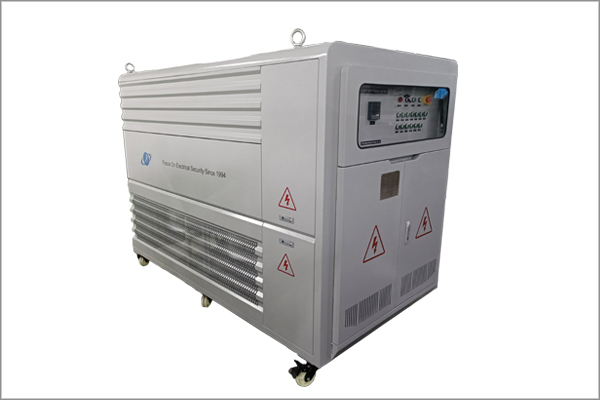How to choose the type of load bank suitable for your specific power system application?
Time:2025-03-21
In power system test, the selection of load bank directly affects the test efficiency, data accuracy and equipment safety. In the face of diverse application scenarios, it is necessary to consider from multiple aspects such as technical parameters, functional requirements, and environmental conditions. Here are the key selection guidelines:
First, according to the type of load classification selection
1. Resistance load bank
Application scenario: steady state active power test (such as the generator set running at full load), pure resistance load simulation.
Features: Simple structure, low cost, can not simulate reactive power.
Typical applications: traditional thermal power/hydropower generator factory test, UPS power load capacity verification.
1000kW Load Bank
2. Reactance load bank
Application scenarios: reactive power compensation test, power factor regulation, power grid voltage stability analysis.
Features: Simulate inductive/capacitive load by adjusting the reactor, which needs to be used with the resistance load bank.
Typical applications: reactive power shock simulation during motor start-up, power capacitor bank switching test.
3. Ac load bank
Application scenario: Three-phase AC system test (such as distribution network and inverter).
Technical requirements: Support frequency tracking (50Hz/60Hz), phase Angle adjustment.
Typical application: grid adaptability test of new energy inverters before grid connection.
4. Dc load bank
Application scenario: DC transmission system, energy storage battery pack, electric vehicle charging pile test.
Key parameters: voltage range (to cover ±110kV and other UHV levels), ripple coefficient control.
Typical applications: UHV converter station valve group debugging, lithium-ion battery charging and discharging cycle test.
5. Energy feedback load bank
Application scenarios: large-scale dynamic testing (such as wind farms, photovoltaic power stations), scenarios that require energy conservation.
Advantage: The test energy consumption will be converted into electrical energy back to the grid, the efficiency of more than 95%.
Typical applications: energy storage system charge and discharge test, electric vehicle fast charge protocol verification.
2. Selection according to functional requirements
1. Dynamic adjustment ability
Step load test: Select the load bank with response time < 10ms, which is suitable for the sudden loading/unloading load test of the generator set.
Continuous adjustable load: Support 0-100% power smooth adjustment, such as power grid frequency fluctuation test.
2. Fault simulation function
Short-circuit fault: Support three-phase or single-phase short-circuit current simulation (for example, 10kA@10ms) to test the breaking capability of the circuit breaker.
Island effect: Select a load bank that supports grid disconnect simulation for microgrid inverter testing.
3. Multi-physical field coupling test
Environmental stress: Select a load bank with temperature and humidity control (-40℃~85℃, 95%RH), such as photovoltaic inverter testing in extreme climates.
Mechanical vibration: anti-vibration design, suitable for vehicle mobile test platform.
3. Select key technical parameters
1. Power capacity
Basic principle: The rated power of the load bank is not less than 120% of the rated power of the device under test.
Case: Test 2000kW generator set, need to select 2400kW and above load bank.
2. Precision index
Power accuracy: 0.5% FS (for metrological certification tests).
Voltage/current accuracy: 0.1% FS (suitable for precision equipment calibration).
3. Cooling method
Natural cooling: Suitable for low power (< 10kW) static testing.
Forced air cooling: suitable for medium power (10kW~500kW) continuous operation.
Liquid cooling/phase change cooling: suitable for high-power (> 500kW) or high ambient temperature scenarios.
4. Safety protection level
IP54: Suitable for indoor dust environment.
IP67: Suitable for outdoor or humid environments (such as substation field testing).
Four, special scenario selection suggestions
1. Uhv transmission system
Selection points: Withstand 100kV/500kA extreme parameters, need to be equipped with partial discharge detection module.
Typical equipment: UHV DC load bank (±110kV/4000A).
2. Grid connection test of new energy
Essential features: Low Voltage Crossing (LVRT) simulation, frequency adaptability testing (47-52Hz).
Recommended model: Intelligent AC load bank (support grid code automatic matching).
3. Digital testing of smart grid
Technology integration: Support 5G communication, real-time linkage with SCADA system.
Case: A provincial power grid adopts iot load bank to realize cross-regional dynamic power flow simulation.
News Recommendation
-
 2024-09-11
2024-09-11TRIUMPH LOAD EXHIBITING AT Enlit Europe 2024 -BOOTH 7.H08
-
 2023-04-21
2023-04-21TRIUMPH LOAD EXHIBITING AT DATA CENTER WORLD GERMANY 2023-BOOTH F909
-
 2023-04-06
2023-04-06TRIUMPH LOAD EXHIBITING AT ELECTRIC POWER TECH KOREA 2023 – Booth G109
-
 2022-05-05
2022-05-05What is the role of ac load bank for power supply?
-
 2022-05-05
2022-05-05What is the role of the load bank?


